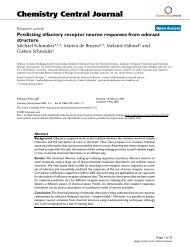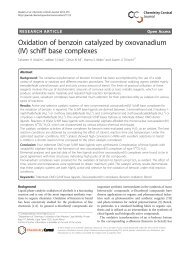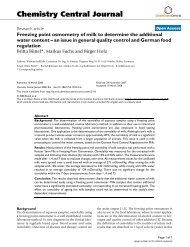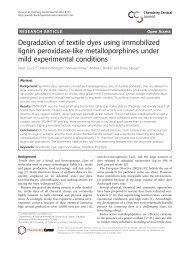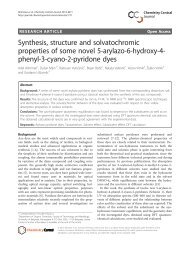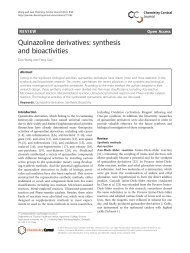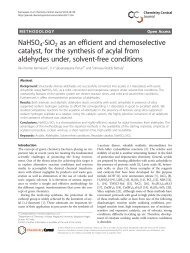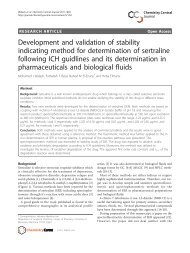Stress degradation studies and development of stability-indicating ...
Stress degradation studies and development of stability-indicating ...
Stress degradation studies and development of stability-indicating ...
You also want an ePaper? Increase the reach of your titles
YUMPU automatically turns print PDFs into web optimized ePapers that Google loves.
Musharraf et al. Chemistry Central Journal 2012, 6:7<br />
http://journal.chemistrycentral.com/content/6/1/7<br />
<strong>of</strong> stock solution with methanol to give solutions in concentration<br />
range <strong>of</strong> 30-1000 μg/mL for calibration curve.<br />
Six-point calibration curve was formed by spotting 6 μL<br />
<strong>of</strong> each st<strong>and</strong>ard solution in concentration range <strong>of</strong> 200-<br />
6000 ng/spot containing both components, each concentration<br />
was spotted thrice on six replicate plates. For<br />
sample preparation, 1 mL ophthalmic samples (P1, P2,<br />
P3 <strong>and</strong> P4) containing 10 mg <strong>of</strong> prednisolone acetate<br />
weredilutedin20mLvolumetricflaskswithmethanol,<br />
separately. Similarly, 1 mL <strong>of</strong> spersinicol <strong>and</strong> chloroptic<br />
containing 0.5% chloramphenicol was diluted in 10 mL<br />
volumetric flasks with methanol. Chloramphenicol capsules,<br />
equivalent to 2500 mg (chlormycetin) were placed<br />
in 500 mL <strong>of</strong> volumetric flask <strong>and</strong> after addition <strong>of</strong> 100<br />
mL water, heated on steam bath till the capsules weredisintegrated.<br />
After further addition <strong>of</strong> 300 mL water, it<br />
was again heated on steam bath with mixing. After cooling<br />
to room temperature, it was diluted to volume with<br />
water. 5 mL <strong>of</strong> the resulting solution was transferred to<br />
100 mL volumetric flask <strong>and</strong> diluted with methanol<br />
[16,17]. 1 mL ophthalmic samples (prednisynth <strong>and</strong> prednicol)<br />
containing 5 mg <strong>of</strong> prednisolone acetate <strong>and</strong> 2<br />
mg chloramphenicol were diluted in 10 mL volumetric<br />
flasks with methanol [4,12]. In similar manner, solutions<br />
for expired spersinicol <strong>and</strong> prednisynth were also prepared<br />
(1 mL in 10 mL volumetric flask). 6 μL <strong>of</strong>each<br />
sample was applied on TLC plate for chromatographic<br />
analysis.<br />
Method validation<br />
The developed method was validated as per the requirements<br />
<strong>of</strong> the ICH guidelines. Linearity was evaluated by<br />
determining six st<strong>and</strong>ard working solutions at a concentration<br />
200-6000 ng/spot. Peak area <strong>and</strong> concentration<br />
was subjected to the least square linear regression equation<br />
to calculate the regression data <strong>and</strong> correlation<br />
coefficients. In order to calculate S/N ratio for LOD <strong>and</strong><br />
LOQ, the formulae used were 3.3 δ/S <strong>and</strong> 10 δ/S,<br />
respectively where δ is the residual error <strong>and</strong> S st<strong>and</strong>s<br />
for slope <strong>of</strong> calibration curve. In order to check the<br />
robustness, following parameters were deliberately changed<br />
within the range <strong>of</strong> ± 5% at three different concentration<br />
levels (200, 400 <strong>and</strong> 800 ng); amount <strong>of</strong> mobile<br />
phase, mobile phase composition, time from spotting to<br />
chromatography, time from chromatography to scanning<br />
<strong>and</strong> chamber saturation time. Intra-day <strong>and</strong> inter-day<br />
precisions were determined with the st<strong>and</strong>ards <strong>and</strong><br />
degraded reaction mixtures. For method repeatability,<br />
assay at three different concentration levels (200, 400<br />
<strong>and</strong> 800 ng) was repeatedly performed six times on the<br />
same day (intra-day). For reproducibility, same samples<br />
at three concentration levels (200, 400 <strong>and</strong> 800 ng) were<br />
analyzed in different days (inter-day) <strong>and</strong> results were<br />
statistically evaluated in terms <strong>of</strong> % R.S.D. For recovery<br />
Page 3 <strong>of</strong> 9<br />
<strong>studies</strong>, pre analyzed pharmaceutical drugs containing<br />
prednisolone acetate (P1), chloramphenicol (C1) <strong>and</strong><br />
both in combination (PC1) were spiked with extra 25,<br />
50 <strong>and</strong> 75% <strong>of</strong> prednisolone acetate <strong>and</strong> chloramphenicol.<br />
The specificity <strong>of</strong> the proposed method was analyzed<br />
by overlapping the densitogram <strong>of</strong> the st<strong>and</strong>ard<br />
<strong>and</strong> samples <strong>and</strong> comparing it at peak start, peak apex<br />
<strong>and</strong> peak end positions.<br />
Preparation <strong>of</strong> forced <strong>degradation</strong> products<br />
Methanolic stock solutions (1 mg/mL) <strong>of</strong> both prednisolone<br />
acetate (set 1) <strong>and</strong> chloramphenicol (set 2) were<br />
prepared, separately <strong>and</strong> in combination (set 3) to perform<br />
forced <strong>degradation</strong> <strong>studies</strong> in parallel synthesizer<br />
by refluxing the reaction mixtures for two hours at 80°<br />
C. After the reactions were completed, all the solutions<br />
were preserved at -80°C till analysis. Average peak areas<br />
<strong>of</strong> active components were analyzed after triplicate<br />
analysis.<br />
For acidic hydrolysis, 1N <strong>and</strong> 5N HCl were used, for<br />
alkaline hydrolysis, 0.1N, 1N <strong>and</strong> 5N NaOH were used<br />
while for neutral hydrolysis Milli Q water was used. 3<br />
mL <strong>of</strong> each concentration <strong>of</strong> acidic <strong>and</strong> alkaline solutions<br />
<strong>and</strong> Milli Q water were added into 3 mL (1 mg/<br />
mL) stock solutions <strong>of</strong> all three sets. To study wet heating<br />
<strong>degradation</strong>, 3 mL (1 mg/mL) <strong>of</strong> stock solution <strong>of</strong><br />
each set 1, set 2 <strong>and</strong> set 3 was subjected to <strong>degradation</strong>.<br />
Oxidation was carried out by adding 1 mL <strong>of</strong> H 2O 2<br />
(35% v/v) in 3 mL stock solution <strong>of</strong> each set. All the<br />
resultant solutions were refluxed for two hours at 80°C<br />
in parallel synthesizer. 1 μL (500ng/spot)<strong>of</strong>1NHCl,<br />
0.5 μL (250ng/spot)<strong>of</strong>5NHCl,4μL (2000 ng/spot) <strong>of</strong><br />
0.1N, 1N <strong>and</strong> 5N NaOH treated solutions, 4 μL (2000<br />
ng/spot) <strong>of</strong> neutral hydrolysis, 6 μL (6000 ng/spot) from<br />
wetheat<strong>degradation</strong>mixture<strong>and</strong>4μL (3000 ng/spot)<br />
from oxidation mixture were applied on TLC plate in<br />
triplicate for chromatographic analysis.<br />
Dry heat <strong>degradation</strong> was conducted by taking st<strong>and</strong>ard<br />
prednisolone acetate <strong>and</strong> chloramphenicol <strong>and</strong><br />
heated in oven at 90°C for 4 hrs. 1 mg <strong>of</strong> each treated<br />
st<strong>and</strong>ard was dissolved in 1 mL <strong>of</strong> methanol <strong>and</strong> 4 μL<br />
(4000 ng/spot) <strong>of</strong> resultant solution <strong>of</strong> each, prednisolone<br />
acetate, chloramphenicol <strong>and</strong> both in combination<br />
was applied on TLC plate in triplicate for chromatographic<br />
analysis. For oxidation reaction at room temperature,<br />
3 mL stock solution <strong>of</strong> each set was added<br />
with 1 mL <strong>of</strong> H 2O 2 (35% v/v) <strong>and</strong> the resultant solutions<br />
were kept for 24 hours at room temperature. 4 μL (3000<br />
ng/spot) <strong>of</strong> each treated solution was applied on TLC<br />
plate in triplicate for chromatographic analysis. In order<br />
to evaluate photochemical <strong>degradation</strong> <strong>of</strong> prednisolone<br />
acetate, chloramphenicol <strong>and</strong> both in combination,<br />
stock solution <strong>of</strong> each set was directly exposed to the<br />
sunlight for three days from 8 to 18 hrs at 30 ± 2°C. 6





